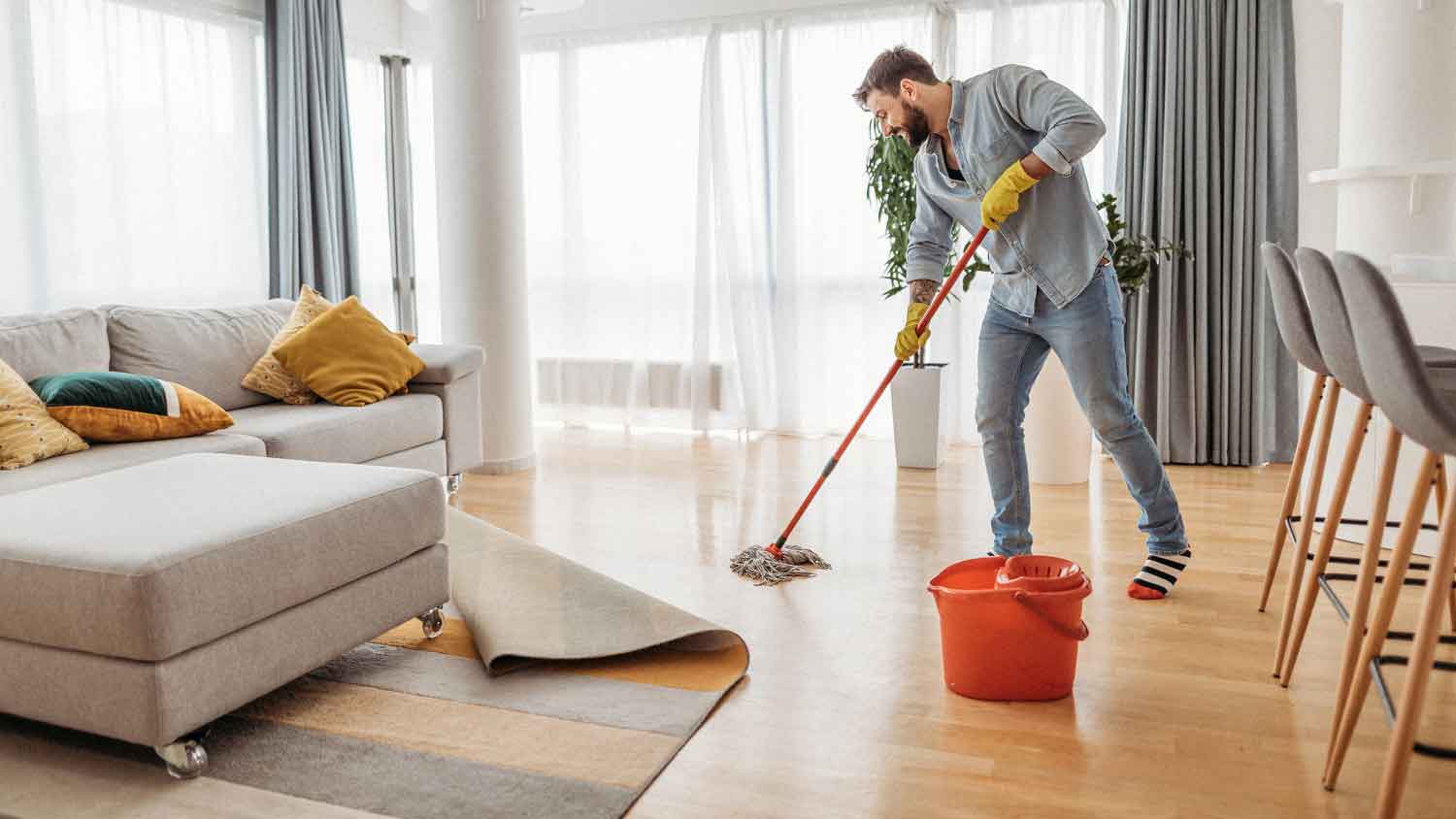A Complete Guide to How to Clean Your Ceilings and Walls
Breathe freely in your home with clean ceilings and walls


Keep your ceilings and walls clean for better breathing.
You can create your own cleaning solutions using household products.
Textured ceilings are harder to clean, so it’s helpful to use a vacuum, broom, or duct tape.
Cleaning ceilings and walls can be a daunting task. Whether you have very high ceilings that require a ladder to clean or an overwhelming amount of wall space in your home, this task may linger on the to-do list for longer than you’d like to admit.
With these cleaning tips, you’ll have all the information you need to perform this task with confidence. However, cleaning ceilings does require the use of a ladder, so if you’re not comfortable with the task, you can always hire a professional cleaner to tackle the job.
Why is it Important to Keep Ceilings and Walls Clean?
Ceilings and walls are breeding grounds for dust, dirt, grime, bugs, and more to collect in your home. Ceilings, in particular, are hotspots for dust and cobwebs due to the height, especially if your home has vaulted ceilings.
The continued dust and debris build-up will not only make cleaning a more difficult task, but it can start to affect the environment of your home. Collected dust and dirt can result in breathing problems for everyone in the home, especially for those who have allergies. That creates an uncomfortable living space and can be unwelcoming for your guests. To avoid this problem, get in the habit of cleaning your walls and ceilings on a regular basis.
How Often Should I Clean My Ceilings and Walls?
You should plan to dust your ceilings and walls once per month. You can do it more frequently as needed, especially during warmer months when you may have windows open. Add an annual deep- clean of your walls and ceilings to your spring cleaning checklist. However, be sure to clean any stains or build-up as you see it to avoid stubborn or permanent stains.
"Dusting down the ceiling, ceiling fans, light fixtures, walls, baseboards, and anything affixed to the walls is the most important step in cleaning the ceiling and walls," says Asya Biddle, Angi Expert Review Board member and manager of The Dustbusters, a family-owned and operated janitorial company in Williamsport, PA.
Best Cleaning Materials and Tools for Ceilings and Walls

Armor yourself with the best tools and cleaning materials to get the job done well so you don’t have to fret over this task.
Duster
The first and most important tool you need when cleaning ceilings and walls is a duster. You’ll want to purchase a duster with a long handle and microfiber attachment. Depending on the height of your ceilings, you may not need a ladder to perform the dusting task. If you have a ceiling fan or beams in hard-to-reach areas, shop for a duster with different attachments or one that bends to accommodate cleaning those areas without a ladder.
"Make sure to give each area at least five minutes to let the dust settle before vacuuming, sweeping, or washing down your ceilings or walls," Biddle says.
Ladder
If you have vaulted ceilings, a ceiling fan, or beams, you’ll likely need a ladder to ensure you reach every nook and cranny when cleaning. You don’t want to leave pesky cobwebs anywhere. Be sure to follow all of the necessary ladder safety tips, like inspecting it beforehand and avoiding distractions.
Protective Gear
It’s a good idea to wear a protective mask or goggles while dusting to prevent dust from getting in your face. If you suffer from allergies, these products are a must. You can also don protective gloves to avoid spreading the dust and dirt.
Cleaning Solution
Luckily, you can use tons of different cleaning solutions on your ceilings and walls. You can whip up a solution using household products or purchase a cleaning solution at your local grocery or home improvement store.
One simple way to make a homemade cleaning solution is to mix 1 cup of warm water, 1 teaspoon of dish soap, and 2 tablespoons of white vinegar in a spray bottle. Then, apply the cleaning solution to your ceilings and walls with a clean cloth or sponge.
Sponge or Cloth
We highly recommended using a natural sea sponge or a clean white cloth when cleaning ceilings and walls. These tools help prevent further staining, which can occurs with the use of colored sponges or towels. The last thing you want is to create a new stain that requires an additional project.
Tips for Cleaning Textured Ceilings
Textured ceilings are tough to clean due to the, well, texture. The crevices make it difficult for a traditional duster to capture debris. Instead, you can use items you probably already have in your home: a vacuum, a broom, or duct tape. Follow these tips to clean textured ceilings in a snap.
1. Use Your Vacuum Attachments
The attachments on your vacuum will be invaluable in helping to remove cobwebs and dust from your textured ceilings. Use an attachment that’s wide and doesn’t have hard plastic. That way, you can reach dust and debris lodged in the crevices of the ceiling
If you have a large or heavy vacuum, consider another option instead to avoid lugging a cumbersome vacuum up a ladder.
2. Sweep Out the Ceilings
Using a broom to sweep the dust out of the nooks and crannies of your ceiling is a great option. You’ll want to ensure you lay a tarp down on the floor to catch any dust. Flip your long-handled broom up and simply sweep, making sure to get the crevices well.
3. Trap Dust with Duct Tape
Duct tape is a handy tool, and now you’ve found another use for it. Wrap duct tape around a paint roller and gently roll it on your textured ceiling. Most of the dust will collect on the tape. You’ll need to keep rolling the tape when dust no longer adheres.
Tips for Removing Stubborn Stains on Ceilings and Walls
It’s impossible to keep ceilings and walls totally stain-free, so learning how to tackle them quickly is the key.
1. Remove Surface Stains First
If you have stains on your walls, you’ll want to dust and clean them with a solution before performing a deep clean. This first step ensures you remove any surface stains before adequately addressing the stain at hand. Plus, you’ll be able to assess the scale and size of the stain once it’s clean.
2. Clear Away Crayon Stains with Baking Soda Solution
Frequent stains parents have to deal with are from crayons. If your child lets out their artistic abilities onto your walls, a baking soda solution can help. Create a paste with two parts baking soda and one part water in a small bowl and rub the solution in a circular motion over the area to remove. This solution also works on grease stains.
3. Use Rubbing Alcohol on Scuff Marks
Rubbing alcohol is a great material for removing scuff marks on your walls. You might have lots of those near your front door or where your family keeps their shoes. Wet a cotton ball with rubbing alcohol and use circular motions on the marks to remove it fully.
4. Assess Ceiling Stains Carefully
If you have stains on your ceilings that are yellow or slightly brown in appearance, you don’t have to paint over to remove them. However, before you clean, you will want to ensure you know the root cause of the stain to rule out continued water damage. Hire a professional plumber to help find the cause of the water damage to avoid putting a band-aid on a more serious problem.
Once you know the cause of the stain and are ready to remove it, mix together a solution of 10 percent bleach and 90 percent water into a spray bottle. While wearing a mask and goggles, spray the stain, allow it to dry, and repeat. After repeating the process about five times, the stain should be gone.





- These Are the Best Tools for Cleaning Hard-to-Reach Areas
- 7 Ways to Clean High Ceilings Safely
- 26 House Cleaning Tips to Elevate Your Cleaning Game
- How to Clean Eggshell Paint Walls in 5 Easy Steps
- Learn How to Clean Your House (and Maybe Even Have Fun Doing It) With These 27 Tips
- DIY Air Duct Cleaning Tools and How to Use Them
- 5 Ways You Can Raise Your Ceiling
- How Mold and Water Damage Affect Paint
- 11 Handy Tips and Tricks to Help With Your Next Home Project
- How to Clean Your Laundry Room: An Easy Laundry Room Cleaning Checklist











